Abstract
Pleurotus ostreatus, classified under the phylum Basidiomycota, order Agaricales, and family Pleurotaceae, is a prevalent gray edible fungus. Its physical damage not only compromises quality and appearance but also significantly diminishes market value. This study proposed an enhanced method for detecting Pleurotus ostreatus damage based on an improved YOLOv8n model, aiming to advance the accessibility of damage recognition technology, enhance automation in Pleurotus cultivation, and reduce labor dependency. This approach holds critical implications for agricultural modernization and serves as a pivotal step in advancing China’s agricultural modernization, while providing valuable references for subsequent research. Utilizing a self-collected, self-organized, and self-constructed dataset, we modified the feature extraction module of the original YOLOv8n by integrating a lightweight GhostHGNetv2 backbone network. During the feature fusion stage, the original YOLOv8 components were replaced with a lightweight SlimNeck network, and an Attentional Scale Sequence Fusion (ASF) mechanism was incorporated into the feature fusion architecture, resulting in the proposed OMB-YOLO model. This model achieves a remarkable balance between parameter efficiency and detection accuracy, attaining a parameter of 2.24 M and a mAP@0.5 of 90.11% on the test set. To further optimize model lightweighting, the DepGraph method was applied for pruning the OMB-YOLO model, yielding the OMB-YOLO-tiny variant. Experimental evaluations on the damaged Pleurotus dataset demonstrate that the OMB-YOLO-tiny model outperforms mainstream models in both accuracy and inference speed while reducing parameters by nearly half. With a parameter of 1.72 M and mAP@0.5 of 90.14%, the OMB-YOLO-tiny model emerges as an optimal solution for detecting Pleurotus ostreatus damage. These results validate its efficacy and practical applicability in agricultural quality control systems.
1. Introduction
Pleurotus ostreatus, a globally popular edible fungus, is highly valued not only for its unique texture and versatile culinary applications, but also for its attributed health benefits. These include traditional medicinal properties such as dispelling wind-cold and relaxing sinews, along with scientifically recognized attributes—specifically, the inhibitory effects of its protein–polysaccharide complexes on cancer cells and its ability to enhance immune function. Currently, Pleurotus ostreatus cultivation remains a labor-intensive industry globally, with production in most regions heavily reliant on manual labor. Furthermore, the development of mechanized equipment for Pleurotus ostreatus farming is comparatively underdeveloped. Consequently, the entire cultivation process—encompassing stages like spawn production, inoculation, bag filling, spawn running/cultivation, harvesting, and grading—exhibits a high dependency on human labor. This dependence leads to significant challenges, including high labor intensity, elevated labor costs, and low production efficiency, which severely impede the modernization of the edible fungi industry. Previous research on Pleurotus ostreatus quality assessment has identified damage as a critical factor compromising quality [1]. Damage detrimentally affects morphological quality, subsequently reducing economic value. Currently, the prevalent method for detecting damage in Pleurotus ostreatus relies predominantly on manual visual inspection. This dependence acts as a bottleneck, slowing progress towards industrialized and automated edible mushroom production. Therefore, establishing an automated, computationally efficient and a highly accurate detection method for Pleurotus ostreatus damage represents an urgent necessity.
With the rapid advancement of deep learning and machine vision technologies in agriculture [2,3,4,5], numerous researchers have recently extended their application to the edible fungi domain. Javanmardi et al. employed a convolutional neural network (CNN) to estimate the shelf life of three widely consumed mushroom varieties (Agaricus bisporus, Lentinula edodes, and Pleurotus ostreatus), finding that ResNet-50 outperformed other models in detecting Agaricus bisporus and Pleurotus ostreatus, achieving overall accuracies of 94.10% and 89.11%, respectively. MobileNet-V2 demonstrated superior performance in identifying Lentinula edodes, attaining an accuracy of 86.36%, marking the first application of machine vision technology to edible fungi preservation [6]. Nuankaew et al. developed an innovative AI-driven system for detecting green mold disease in Pleurotus ostreatus, which integrated deep learning, convolutional neural networks (CNNs), and Internet of Things (IoT) technology using the DenseNet201 algorithm, achieving a disease detection accuracy of up to 92.50%. This system facilitates timely identification and response to potential disease outbreaks, thereby enhancing cultivation efficiency and reducing yield losses, offering a disease-oriented approach to monitoring factors affecting Pleurotus ostreatus quality [7]. Zahan et al. compared deep learning methods including InceptionV3, VGG16, and ResNet50 for classifying 8190 mushroom images by species, achieving an accuracy of 88.40% [8]. Subramani et al. evaluated various deep learning algorithms—Support Vector Machine (SVM), ResNet50, YOLOv5, and AlexNet—which were optimized for efficiently classifying mushrooms into toxic and non-toxic categories, ultimately identifying SVM as the most effective model with an accuracy of 83% [9].
Multiple researchers have similarly applied YOLO models to the edible fungi domain. Wang et al. proposed Mushroom-YOLO, an enhanced YOLOv5-based deep learning algorithm for mushroom growth recognition, achieving 99.24% mean average precision in small object detection such as mushrooms. They further introduced an iMushroom-based prototype system for yield recognition of Lentinula edodes (shiitake mushrooms). Case studies with both prototype implementations and real-world cultivation demonstrated its efficacy. This offers a potential approach for unattended monitoring of growth quality in indoor shiitake cultivation. Such advancements contribute to agricultural modernization efforts [10]. Lu et al. implemented the required algorithms, functions, and human–machine interface using C++, leveraging Microsoft Windows OS and MQTT (Message Queuing Telemetry Transport) brokers for message broadcasting. Greenhouse images were captured via IP cameras, with mushroom identification and localization performed using YOLOv3, though the study did not report quantitative accuracy metrics [11].
Current research on YOLO enhancements in edible fungi predominantly focuses on accuracy improvement, with limited exploration of model lightweighting. Our prior work on Pleurotus ostreatus quality assessment similarly employed lightweight module substitution. This reduced parameters from 3.01 M to 2.23 M relative to the original model [1]. Cong et al. developed MYOLO, a lightweight detection model for fresh shiitake mushroom based on YOLOv3. The MYOLO model achieved a mean Average Precision (mAP) of 97.03% with a parameter count of 29.8 M and an inference speed of 19.78 ms. Compared to the original YOLOv3, this represents an mAP improvement of 2.04%, a 2.08-fold parameter reduction, demonstrating strong real-time performance and detectability. However, this work was limited to shiitake mushroom detection and did not extend to morphological or quality analysis [12]. Ma et al. developed FES-YOLOv5s, a lightweight detection model for Agaricus bisporus, replacing the backbone with the lighter FasterNet architecture. This modification reduced computational load by 42.7% compared to baseline YOLOv5s [13].
In summary, while machine vision technologies have been applied and advanced in edible fungi research, significant potential remains for improvement in damaged object detection and model lightweighting applications. To bridge these gaps, we integrate four synergistic techniques: GhostHGNetv2, SlimNeck, ASF, and DepGraph. This unified framework achieves concurrent model compression and accuracy enhancement. Furthermore, it attains an optimal accuracy–parameter balance on the Pleurotus ostreatus damage dataset. The principal innovations encompass the following:
- Addressing the critical gap in damage recognition for edible fungi: we established OMB-YOLO—a Pleurotus ostreatus damage detection model derived from YOLOv8n—using a self-collected and self-built dataset. Through pruning methods, the refined OMB-YOLO-tiny version achieved nearly 50% parameter reduction while retaining detection accuracy. This approach addresses two critical limitations—model lightweighting and intelligent damage recognition—thereby advancing smart agriculture technologies within the edible fungi sector.
- Within the feature extraction network, this study replaces the original backbone with GhostHGNetv2, achieving significant reductions in model parameters and computational demands while maintaining high detection accuracy. GhostHGNetv2 is a lightweight and efficient convolutional neural network architecture that employs HGStem (High-Resolution Group Stem) in its first layer to enhance fine-grained feature capture capabilities while preserving computational efficiency. The implementation of HGStem establishes a robust foundation for subsequent feature extraction and processing. Long-range attention mechanisms are incorporated to enhance model performance, particularly optimizing lightweight operations. Furthermore, the integration of Squeeze-Excitation Blocks elevates feature representation capabilities, ultimately boosting overall model efficacy [14].
- The feature fusion network employs SlimNeck, a lightweight neck design paradigm. First, GSConv—a lightweight convolution method—replaces Standard Convolution (SC), reducing computational costs to approximately 60–70% of SC’s while maintaining equivalent learning capacity. Building upon GSConv, we introduce GSbottleneck and develop the VoV-GSCSP module (Cross-Stage Partial Network with GSConv). The VoV-GSCSP module reduces computational and architectural complexity while preserving sufficient accuracy, achieving optimal accuracy–complexity trade-offs. To enhance small-target detection precision for damaged Pleurotus ostreatus, we integrate the Attention-based Scale Fusion (ASF) mechanism into SlimNeck [15]. ASF leverages the Scale Sequence Feature Fusion (SSFF) module to strengthen multi-scale feature extraction capabilities, and utilizes the Triple Feature Encoder (TPE) to fuse multi-scale feature maps for enriched detail representation. Additionally, the Channel and Position Attention Mechanism (CPAM) is incorporated to focus on channel-wise and spatial information for small targets—particularly damaged areas, thereby boosting small-target detection performance in Pleurotus ostreatus damage assessment [16].
- To achieve further model lightweighting, this study employs the DepGraph universal structured pruning methodology. This approach guarantees synchronous pruning across heterogeneous layers while ensuring all parameters in pruned groups remain functionally insignificant, thereby preventing significant post-pruning performance degradation. Comparative analysis demonstrates DepGraph’s superior adaptation for lightweighting Pleurotus ostreatus damage detection models over alternative pruning techniques [17].
2. Materials and Methods
2.1. Data Acquisition
The Pleurotus ostreatus damage dataset was collected at the research-teaching facility of Jilin Agricultural University’s Institute of Smart Agriculture, Changchun, Jilin Province, China (125.379513° E, 43.811581° N). Data collection captured naturally occurring damage during routine cultivation, as well as damage arising from suboptimal transportation or harvesting practices. To ensure authenticity, no artificial damage was introduced; the dataset reflects only naturally occurring damage during growth and harvesting, and our data are collected under various complex backgrounds to ensure the generalization ability of the model. Cultivation under controlled artificial conditions enabled continuous observation and documentation of the growth cycle. Ambient temperature ranged from 5 °C to 30 °C with 80–90% relative humidity throughout collection. Damage types and severity levels observable in natural growth environments were systematically recorded. Documented natural damage encompassed physical impact, climate-induced environmental stressors, and growth-related phenomena. Multisession imaging across varying growth stages and under differential lighting/temperature conditions ensured dataset diversity and representativeness. This methodology captured authentic variations in Pleurotus ostreatus damage manifestations across heterogeneous environmental regimes. The final dataset comprises 904 raw images across four damage categories: cap tear, cap missing, cap broken, and pleat broken. Quantitative distributions are detailed in Table 1, with morphological exemplars of healthy Pleurotus ostreatus and damaged specimens illustrated in Figure 1.

Table 1.
Distribution of raw image data.
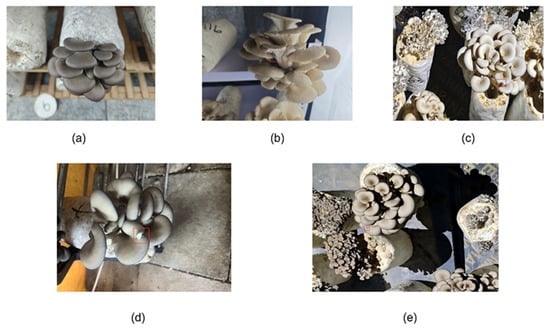
Figure 1.
Representative specimens: (a) healthy Pleurotus ostreatus, (b) pleat broken, (c) cap missing s, (d) cap tear, (e) cap broken.
2.2. Data Preprocessing
Image preprocessing is critical for enhancing data diversity and improving model training efficacy [18]. The collected images were initially partitioned into training, validation, and test sets at an 8:1:1 ratio. To enhance the model’s generalization ability, data augmentation techniques such as random cropping, brightness adjustment, and rotation were applied extensively during training (Figure 2). Annotation consistency was maintained by synchronizing corresponding label files during the augmentation process. The final augmented dataset comprised 3616 images, establishing a robust foundation for model training and evaluation, and it effectively prevents problems such as overfitting.
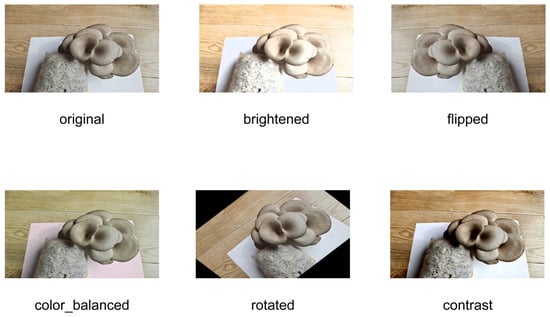
Figure 2.
Demonstration of data augmentation operations.
2.3. Base Model Selection and Improvement Methodology
2.3.1. YOLOv8 and OMB-YOLO
Since its initial release in 2015, the YOLO (You Only Look Once) series has remained among the most prominent computer vision models. This architecture concurrently executes object detection and classification within a unified neural network framework. Utilizing single-pass inference, YOLO predicts bounding boxes and class probabilities for all objects in an image. Its high accuracy, recall rates, rapid inference speed, and compatibility with embedded systems have enabled broad agricultural applications [19]. This study adopts YOLOv8—the variant exhibiting optimal accuracy–efficiency balance—as the foundation for Pleurotus ostreatus damage detection. YOLOv8 offers multiple versions (YOLOv8n to YOLOv8x) to accommodate diverse application requirements [20]. The architecture integrates CSPNet backbone with Focus modules for efficient spatial downsampling, while fusing PANet and FPN for robust multi-scale feature fusion. Building upon this foundation, we propose OMB-YOLO [21]. The lightweight and modular design of OMB-YOLO-tiny, along with the integration of attention mechanisms, contributes to improved generalization across diverse visual inputs. For feature extraction, GhostHGNetv2—integrating Ghost modules with HGNetv2—achieves lightweight refinement, enhancing detection performance while substantially reducing parameters and computations, thereby offering an efficient solution for lightweight object detection. In the feature fusion network, two key enhancements are implemented: Slim-Neck replaces the native YOLOv8 neck to maintain accuracy while reducing parameters, while Attentional Scale Sequence Fusion (ASF) is integrated with SlimNeck to further boost accuracy. These modifications collectively improve accuracy while advancing model lightweighting. DepGraph pruning is subsequently applied to OMB-YOLO, reducing parameters from 3.01 M to 1.72 M and computations from 8.1 GFLOPs to 5.6 GFLOPs. The architecture of OMB-YOLO (termed OMB-YOLO-tiny) is illustrated in Figure 3.
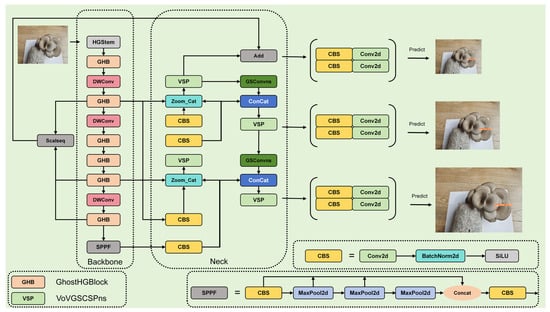
Figure 3.
Architecture of OMB-YOLO (OMB-YOLO-tiny).
2.3.2. Enhancement of Feature Extraction Network
In April 2023, Baidu pioneered the first real-time DETR model RT-DETR, integrating Ghost modules with HGNetv2 to establish the GhostHGNetv2 architecture. The optimized Ghost_HGBlock module—developed by refining HGBlock with GhostConv—significantly reduces model parameters and computational demands while preserving high detection accuracy. Comprising multiple Ghost_HGBlock units, GhostHGNetv2 refines YOLOv8’s backbone network, lowering computational complexity and parameter scale without compromising detection performance. Detection accuracy and model lightweighting constitute critical evaluation metrics for Pleurotus ostreatus damage detection models. Limited hardware resources necessitate balancing detection accuracy against computational costs in practical deployments. However, YOLOv8’s tendency to generate parameter redundancies during training hinders deployment on resource-constrained hardware. To address this, integrating Ghost modules with HGNetv2 maintains competitive detection performance while substantially reducing parameters and computations—delivering a viable lightweight detection optimization framework [22]. This approach provides foundational insights for developing balanced lightweight–precision models in Pleurotus ostreatus damage detection.
This study employs GhostHGNetv2 as the feature extraction backbone for both OMB-YOLO and OMB-YOLO-tiny. Building upon HGNetV2’s architecture, GhostHGNetv2 integrates GhostConv as the convolutional layer within HGBlock. This configuration minimizes model parameters and computations while enhancing computational efficiency and reducing footprint, thereby improving generalization capability and operational performance without compromising detection accuracy. GhostHGNetv2 comprises three core components: HGStem, GhostHGBlock, and DWConv (Depth-wise Convolution). HGStem serves as the preprocessing layer, with its architectural design detailed in Figure 4.
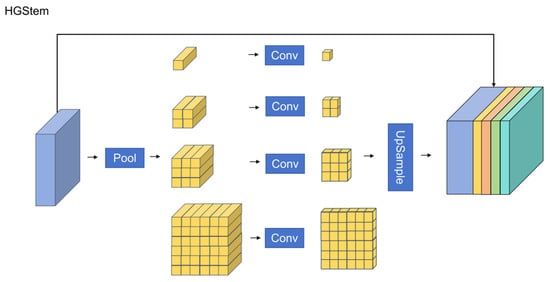
Figure 4.
Architecture diagram of HGStem.
Convolutional operations perform initial feature extraction on input images. Max-pooling operations then downsample the data to capture multiscale feature variations. This process enriches feature representations and enhances the model’s expressive capacity through fusion with convolutional feature maps [23].
HGBlock serves as the feature extraction layer, employing multi-scale convolutional kernels to capture heterogeneous features from input data. This enables hierarchical feature representation across network depths. The GhostConv module synthesizes supplementary feature maps via low-cost linear transformations, enriching feature representations while minimizing computational overhead [24]. This approach reduces computational costs by ~40% without compromising model performance. The module operates through two stages: primary convolution and economical operations. Primary convolution utilizes 1 × 1 kernels to reduce feature channel dimensionality, generating base feature maps while minimizing computational load for subsequent stages. Economical operations then synthesize distinct Ghost feature maps through depth-wise separable convolutions. Final feature enrichment is achieved through channel-wise concatenation of base and Ghost feature maps. The architecture of Ghost_HGBlock is detailed in Figure 5.
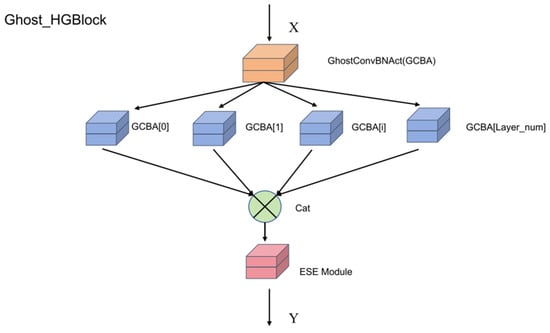
Figure 5.
Architecture diagram of Ghost-enhanced HGBlock.
Depthwise Separable Convolution, an efficient convolutional architecture, has been extensively adopted in lightweight neural network designs in recent years. This architecture decomposes standard convolution into depthwise convolution (spatial feature extraction) and pointwise convolution (cross-channel fusion), substantially reducing computational complexity and parameter counts. Specifically, the depthwise convolution stage performs spatial feature extraction independently per input channel, requiring only 1/N parameters compared to standard convolution (where N denotes output channels); subsequently, pointwise convolution executes cross-channel feature fusion via 1 × 1 kernels, enabling channel-wise information integration [25]. This mechanism critically balances accuracy and lightweighting in OMB-YOLO. Figure 6 sequentially illustrates the depthwise convolution and pointwise convolution operations.
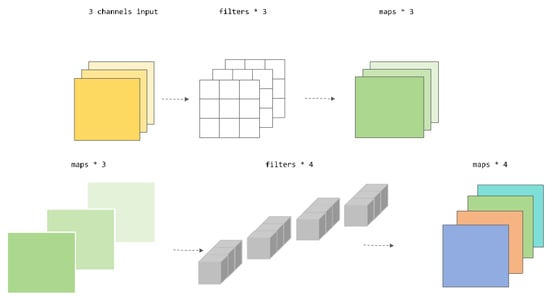
Figure 6.
Schematic Diagram of depthwise convolution and pointwise convolution. Where “*” stands for multiplication, e.g., maps*4 is four maps.
2.3.3. Attentional Scale Sequence Fusion (ASF)
Attentional Scale Sequence Fusion (ASF) is a novel YOLO-based architecture initially designed for cell instance segmentation. ASF integration into the YOLO framework enhances cellular image segmentation performance. We adapt ASF for Pleurotus ostreatus damage detection owing to its superior performance and low parametric overhead. ASF comprises the following: (1) Scale Sequence Feature Fusion (SSFF), enhancing multi-scale feature extraction capability; (2) Triple Feature Encoder (TFE), fusing multi-scale feature maps for enriched detail representation; (3) Channel and Position Attention Mechanism (CPAM), integrating SSFF/TFE outputs to focus on channel relationships and spatial localization of small objects, thereby boosting detection/segmentation accuracy.
The SSFF module is a core component for processing multi-scale information. Its primary function is to strengthen a network’s capability for extracting features across varying scales. By aggregating features from hierarchical network layers, SSFF generates richer and finer-grained feature representations, improving model performance for variably sized objects. This enables more effective identification of subtle damage details in Pleurotus ostreatus imagery, enhancing overall detection performance. Scale space is constructed along the image scale dimension, representing both discrete scale and continuous scale ranges of targets. Scale governs image detail resolution: blurred images lose fine details while preserving structural characteristics [26]. Scaled inputs for SSFF are generated via:
where (w,h) denotes a 2D input image with width w and height h. Fσ(w,h) is generated by applying a series of convolutions under the 2D Gaussian filter Gσ(w,h) for smoothing. σ is the standard deviation parameter of the 2D Gaussian filter used for convolution.
The Triple Feature Encoder (TFE) module in ASF is an innovative feature fusion mechanism designed to process input feature maps of varying dimensions. It processes features from distinct network layers through convolution, batch normalization, and activation functions. The module then employs upsampling and downsampling techniques to standardize spatial dimensions, ensuring dimensional uniformity across feature maps. Finally, it concatenates these multi-scale feature maps to form an integrated representation, capturing richer contextual information and finer details [27]. This design enables the network to process multi-scale information more effectively, as illustrated in Figure 7.
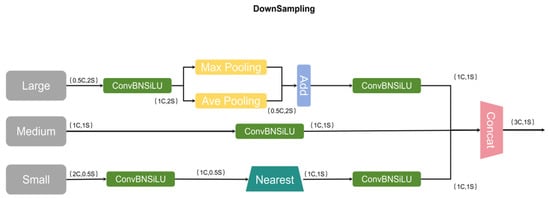
Figure 7.
Architecture of the Triple Feature Encoder (TFE) module, illustrating input processing of multi-scale feature maps (C = channel dimensions; S = spatial dimensions).
Finally, Pleurotus ostreatus damage often manifests as small objects in images. The Channel and Position Attention Mechanism (CPAM) provides an effective enhancement strategy by integrating Scale Sequence Feature Fusion (SSFF) and Triple Feature Encoder (TFE) modules to improve detection capability for detail-rich small objects. CPAM focuses on information-rich channels and spatially correlated small-object features, delivering targeted attention guidance to the model. This mechanism enables precise localization and identification of minute targets, thereby boosting detection performance [28]. The architectural details are presented in Figure 8.
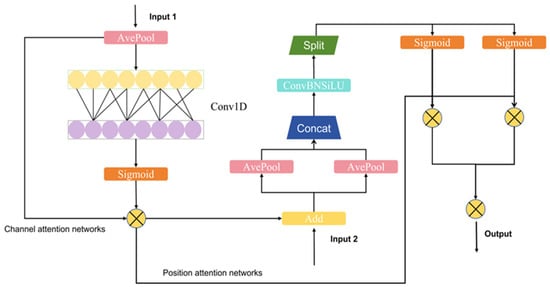
Figure 8.
Architecture of the Channel and Position Attention Mechanism (CPAM), integrating channel and spatial attention pathways (ⓧ = Hadamard product).
2.3.4. SlimNeck Lightweight Neck Network
OMB-YOLO employs the Slim-Neck module comprising two components: GSConv and VoV-GSCSP. The neck architecture integrates GSConv and replaces a portion of the C2F module with VoV-GSCSP [29]. GSConv accelerates inference by optimizing the progressive spatial-to-channel information transition during image processing in CNNs. Dense convolution preserves hidden connections, whereas sparse convolution severs them. GSConv preserves critical connections while reducing computational overhead induced by model depth, and eliminates transformation requirements when processing high-aspect-ratio feature maps in the neck stage [30]. Thus, GSConv is ideal for neck operations when feature maps require no further compression, as it maintains connectivity while minimizing redundant information. For real-time Pleurotus ostreatus damage detection, GSConv is optimal for lightweight convolutional operations in the neck section. The GSConv architecture is detailed in Figure 9.
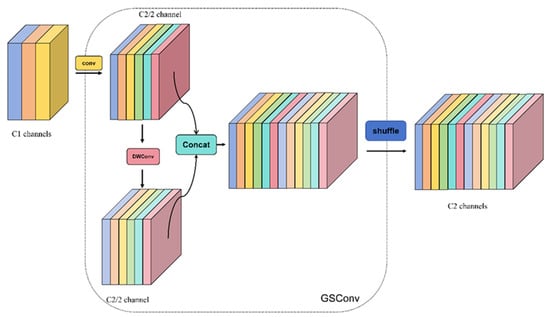
Figure 9.
Architecture of Lightweight GSConv Module.
GSConv provides an effective approach to reduce model complexity while maintaining accuracy, achieving an improved accuracy–speed equilibrium in OMB-YOLO. Furthermore, its Slim-Neck design paradigm enhances the detector’s computational cost-effectiveness. Here, we implement VoV-GSCSP modules to replace C2F modules in the neck section, delivering superior efficiency and performance. Figure 10 illustrates the VoV-GSCSP architecture.
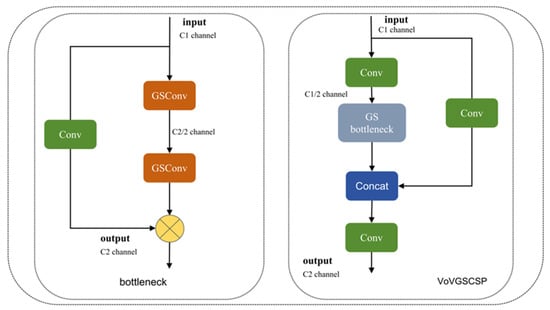
Figure 10.
Architecture of VoV-GSCSP.
2.3.5. DepGraph Model Pruning Methodology
To achieve further lightweight optimization of OMB-YOLO, this study employs DepGraph (Dependency Graph)—a universal pruning scheme applicable to any structured pruning task. It enables automatic parameter grouping and significantly enhances generalization of structured pruning across diverse network architectures, including CNNs, RNNs, GNNs, and Vision Transformers, as detailed below [17].
First, the network is decomposed into finer and more fundamental components, denoted as F = {, ,…},where each component refers to a parameterized layer (e.g., convolution) or a non-parametric operation (e.g., residual addition). Instead of modeling relationships at the layer level, we focus on dependencies between the inputs and outputs of layers. Specifically, the input and output of component are denoted as and , respectively. For any network, the final decomposition can be formalized as = , ,……, , . This representation facilitates easier dependency modeling and allows distinct pruning schemes for the same layer. By redefining the neural network as Equation (3), two primary types of dependencies can be identified: inter-layer dependencies and intra-layer dependencies. The formulation is as follows:
where denotes connectivity between adjacent layers. Analyzing these dependencies yields simple yet universal modeling rules:
- (1)
- Inter-layer dependency: A dependency is consistently induced for connected layers .
- (2)
- Intra-layer dependency: If and share the same pruning scheme, denoted sch() = sch(), a dependency exists.
First, inter-layer dependencies can be readily estimated given the network’s topology. For connected layers , the dependency inherently exists because and correspond to the same intermediate features.
Second, intra-layer dependencies require simultaneous pruning of a single layer’s input and output. Many layers satisfy this condition, such as Batch Normalization (BN) layers, where inputs and outputs share the same pruning scheme sch() = sch(). Conversely, layers like convolutions exhibit distinct pruning schemes for inputs and outputs (w[:,k,:,:] ≠ w[k,:,:,:]), resulting in sch() ≠ sch(); thus, no dependency exists between their inputs and outputs.
Given these rules, the dependency modeling can be formalized as:
where ∧ and ∨ denote logical AND and OR, 1 is an indicator function returning True if the condition holds, and the second term captures intra-layer dependencies introduced by shared pruning schemes. Notably, DepGraph is a symmetric matrix, i.e., D ). Therefore, all input–output pairs can be evaluated to construct the dependency graph, as visualized in the figure for a CNN block with residual connections.
3. Results
3.1. Experimental Environment and Parameters
All experiments were conducted using an Intel(R) Xeon(R) 5218 CPU @2.30 GHz/2.29 GHz (dual processors) and an NVIDIA GeForce RTX 4090 24 GB GPU (core frequency: 2230–2520 MHz, memory bus width: 384-bit) under a 64-bit Windows 10 operating system. The software environment included PyTorch 2.0.0 and Python 3.8. Training configurations comprised an input image size of 640 × 640 pixels, a batch size of 16, and 300 training epochs, with weights saved every 10 epochs. Additionally, the initial learning rate was set to 0.0015, momentum to 0.900, and the NAdam optimizer was employed to minimize the loss function.
3.2. Evaluation Metrics
Mean Average Precision (mAP): This metric quantifies the model’s average detection accuracy across multiple object classes. mAP is calculated as the mean of per-class average precision scores [31]. See formula for details (5) and (6).
Let denote the total number of target classes, q represent a specific object class in detection tasks, and AP(q) denote the Average Precision value for class q.
Frames Per Second (FPS): FPS is a widely used metric for evaluating model detection speed, defined as the number of images processed per second.
Parameters (Params): Params serve as a metric to assess the spatial complexity (i.e., memory footprint) of a model.
Giga Floating-Point Operations (GFLOPs): GFLOPs quantify the temporal complexity (i.e., computational cost) of a model by measuring the total floating-point operations required for inference.
3.3. Pruning Experiments
In the pruning experiments, we compared the performance of various pruning methods on the OMB-YOLO-tiny model to evaluate the superiority of the DepGraph pruning method. The tested methods included lamp pruning, random pruning, L1-norm pruning, Group Hessian pruning, Group Taylor pruning, and DepGraph pruning, with evaluation metrics focusing on mAP@0.5, mAP@0.5:0.95, Params, and FPS. The results demonstrated that the model pruned with DepGraph achieved the best overall performance, attaining an mAP@0.5 of 90.14%, an mAP@0.5:0.95 of 68.71%, a parameter count reduced to 1.72 M, and a high inference speed of 93.1 FPS. In comparison, L1 pruning yielded an mAP@0.5 of 90.03%, a parameter count of 1.73 M, and an FPS of 90.3. Group Taylor pruning achieved an mAP@0.5 of 90.08%, a parameter count of 1.82 M, and an FPS of 90.8, while random pruning resulted in an mAP@0.5 of 90.11%, a parameter count of 1.84 M, and an FPS of 89.1. As detailed in Table 2 (Figure 11 visualizes the corresponding metrics), pruning experiments demonstrate that DepGraph significantly reduces model parameters while optimally maintaining detection accuracy and inference speed. These results validate DepGraph’s efficacy for lightweight model optimization, achieving a currently optimal solution balancing precision and model compactness. This provides robust technical support for deploying models on resource-constrained devices, establishing DepGraph as the best-suited pruning methodology for this research.

Table 2.
Table of pruning experiment results.
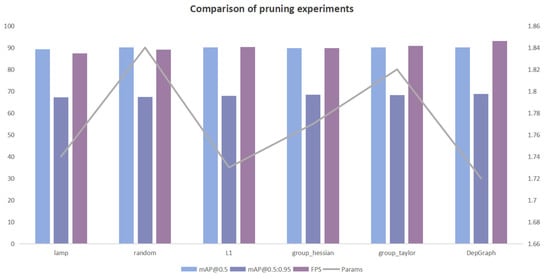
Figure 11.
Comparative visualization of pruning experiments.
3.4. Ablation Studies
In this study, a series of ablation experiments were conducted to comprehensively evaluate the impact of individual components in the OMB-YOLO-tiny model, including the GhostHGNetv2 backbone, SlimNeck neck network, Attention-based Scale Sequence Fusion (ASF) technique, and DepGraph pruning method. Starting from the baseline YOLOv8 model, each component was incrementally integrated to analyze its specific contribution to model performance. The baseline model achieved an mAP@0.5 of 87.64% with 3.01 M parameters. Upon introducing GhostHGNetv2, the mAP@0.5 improved to 88.77%, while the parameter count decreased to 2.31 M. Adding SlimNeck further enhanced the mAP@0.5 to 89.54%, with a slight parameter increase to 2.93 M. Incorporating the ASF technique elevated the mAP@0.5 to 90.11% and reduced parameters to 2.24 M. Finally, the complete OMB-YOLO-tiny model, optimized with DepGraph pruning, maintained a high mAP@0.5 of 90.14% while significantly reducing parameters to 1.72 M. As detailed in Table 3, these experiments validate the efficacy of each component and demonstrate the viability of OMB-YOLO-tiny on resource-constrained devices, revealing an effective model optimization pathway that fulfills this study’s fundamental intent of balancing precision and parameter complexity, while providing significant reference value for future research.

Table 3.
Table of ablation experiment results.
3.5. Comparative Experiments
In this study, we conducted comprehensive comparative experiments between the OMB-YOLO-tiny model and other mainstream object detection models, including Faster RCNN, YOLOv3-tiny, YOLOv5s, YOLOv6s, YOLOv7-tiny, YOLOv10n, and YOLO11n, to validate its performance advantages in the mushroom damage detection task. Experimental results demonstrate that OMB-YOLO-tiny outperforms others across multiple key metrics. In detection accuracy, OMB-YOLO-tiny achieved an mAP@0.5 of 90.14%, surpassing Faster RCNN (37.82%), YOLOv3-tiny (66.52%), YOLOv5s (86.57%), and YOLOv7-tiny (73.12%). Simultaneously, OMB-YOLO-tiny maintains only 1.72 M parameters, significantly fewer than Faster RCNN (28.48 M), YOLOv3-tiny (11.57 M), and YOLOv5s (7.02 M), highlighting its lightweight design advantages. Furthermore, regarding computational complexity, OMB-YOLO-tiny requires merely 5.6 GFLOPs while achieving an inference speed of 93.1 frames per second (FPS), substantially outperforming other models. Compared with the closest improved model YOLOv10, OMB-YOLO-tiny shows marginally higher mAP@0.5 (90.14% vs. 87.33%) while reducing parameters by 33%, further validating its balanced capability between detection accuracy and resource efficiency. These empirical findings validate the efficacy of all components and demonstrate the viability of OMB-YOLO-tiny on resource-constrained devices, revealing an efficient model optimization pathway that precisely achieves the core research objective of balancing accuracy and parameter complexity, while establishing significant reference value for future investigations. For details, see Table 4 and Figure 12, Figure 13 and Figure 14.

Table 4.
Table of comparative experiments results.
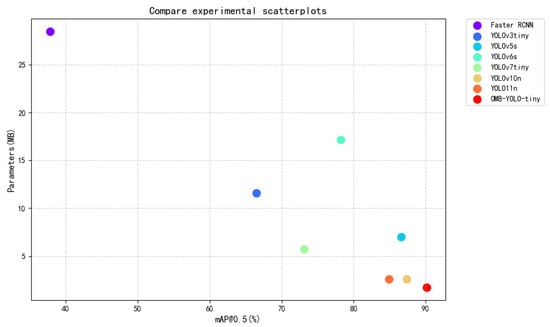
Figure 12.
Parameter-mAP@0.5 scatter plot comparison.
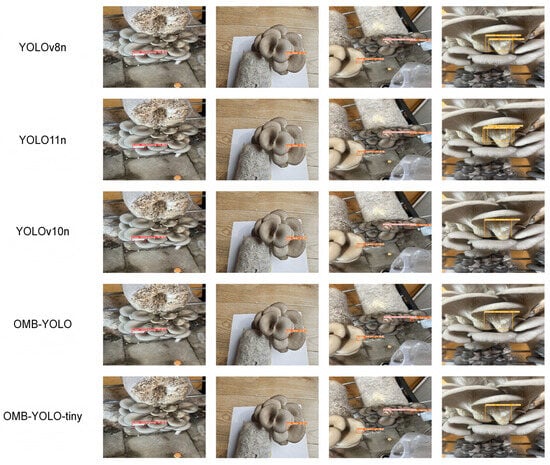
Figure 13.
Comparative predictive performance across models.
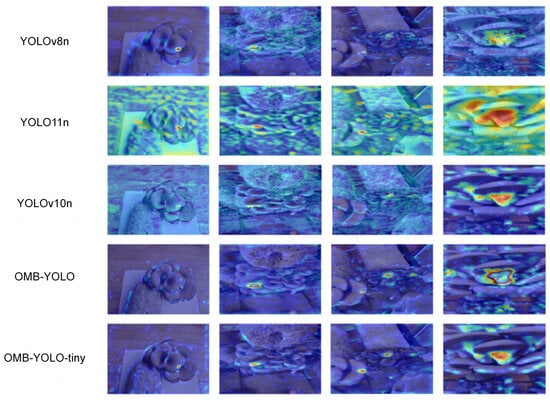
Figure 14.
Heatmap visualization comparison.
Figure 12 illustrates the relationship between model parameters and mAP@0.5, demonstrating that OMB-YOLO-tiny achieves optimal accuracy with minimal parameters.
3.6. Discussion
The OMB-YOLO-tiny model we proposed introduces the following innovations in detecting damage to Pleurotus ostreatus compared to previous studies. First, although the application of information technology in the edible fungi field has made some progress, most studies have typically focused on aspects such as the classification of specific mushroom types or maturity assessment. These studies mainly concentrate on species identification, quality grading, and similar areas, while research on factors that affect the economic value of edible fungi, especially in terms of damage, is relatively limited. The economic value of edible fungi is not only related to their appearance and taste but is also influenced by potential damages, diseases, or environmental factors that may arise during production. In particular, for important edible mushroom species like Pleurotus ostreatus, damage directly impacts its market sales and consumption. Therefore, the ability to identify and assess damage during production in a timely and effective manner has become one of the key factors in improving the production efficiency and product quality of edible fungi. The OMB-YOLO-tiny model proposed in this paper innovatively expands the application of information technology in the edible fungi field by focusing on the detection of damage in Pleurotus ostreatus. It breaks through the previous limitations of applying information technology mainly to classification and maturity assessment, thereby broadening its direction of application within the edible fungi field. Unlike previous research, we do not focus on mushroom classification or maturity but aim to use information technology for the automated detection of damage that may occur to Pleurotus ostreatus during production. By utilizing this model, the efficiency and accuracy of damage detection can be significantly improved, enabling the timely identification of damage caused by transportation, processing, or natural growth. Appropriate measures can then be taken to prevent such damage from affecting market prices, ultimately enhancing the overall economic value of edible fungi.
While prior precision-focused research (such as Javanmardi et al.’s study on mushroom species classification and shelf-life estimation, and Nuankaew et al.’s research on green mold disease detection [6,7,8,9]) has advanced machine vision technology for edible fungi, it has overlooked high-precision recognition of Pleurotus ostreatus damage. OMB-YOLO-tiny fills this gap by constructing a comprehensive dataset covering various damage forms in natural cultivation environments. This model achieves efficient multi-class damage detection, effectively addressing the core quality issues that impact the economic value of Pleurotus ostreatus.
Additionally, in terms of architecture design, previous optimization strategies primarily focused on isolated improvements: for example, Cong et al.’s MYOLO, a lightweight YOLOv3 for shiitake mushroom (Lentinula edodes) detection, but without deep precision optimization [12]; Wang et al.’s Mushroom-YOLO improved small target detection accuracy but did not address model compression [10]; and Ma et al.’s FES-YOLOv5s used lightweight module substitution, but it was limited to backbone replacement [13]. In contrast, OMB-YOLO-tiny achieves innovation through the synergistic integration of the following components: GhostHGNetv2 reduces the computational overhead of feature extraction while retaining accuracy, SlimNeck strikes the optimal balance between accuracy and parameters, ASF enhances multi-scale perceptual capabilities and spatial-channel attention to damage, and DepGraph pruning further compresses the model. This research integrates four existing lightweight improvements (GhostHGNetv2, SlimNeck, ASF, DepGraph) and proposes a new method for balancing accuracy and model lightweighting in YOLO models for the edible fungi field.
As a result, OMB-YOLO-tiny maintains exceptional detection accuracy while significantly reducing parameters and FLOP requirements, achieving faster inference speeds. This extreme lightweight design, high real-time performance, and competitive accuracy enable seamless deployment on resource-constrained agricultural edge devices and mobile systems. For example, it can be integrated into farm sorting lines for automated, real-time post-harvest damage detection and grading of Pleurotus ostreatus. It can also be implemented on handheld terminals or inspection robots for portable applications, enabling rapid on-site damage screening and quality assessment, greatly reducing dependence on manual labor and improving automation. This research holds significant practical and theoretical value for the industrialization and modernization of global edible fungi cultivation. In practice, automating visual inspection significantly reduces the need for manual grading, which is especially critical in the mushroom industry amid labor shortages.
In terms of generalization ability, the model maintains high recognition accuracy across different simulated lighting conditions in the test set, demonstrating its robustness and good generalization ability in real agricultural scenarios. However, we must acknowledge certain limitations of the model. For instance, while it is effective for the four recorded types of Pleurotus ostreatus damage, future research should extend to a broader range of damage types and other categories that affect the economic value of Pleurotus ostreatus. Moreover, to further enhance the model’s generalization ability, we plan to collect more data on damage types across different environments and conduct cross-environment validation to ensure consistent accuracy under various growth stages and external factors.
4. Conclusions
This study proposes an enhanced lightweight YOLOv8n-based model, named OMB-YOLO-tiny, for detecting damage in Pleurotus ostreatus. We constructed a dataset that recorded four types of natural damage (cap tear, cap missing, cap broken, pleat broken) in real cultivation environments. Data augmentation techniques were used to enhance the model’s generalization ability under complex agricultural conditions. By integrating the lightweight GhostHGNetv2 backbone, feature extraction efficiency was optimized. The SlimNeck architecture improved multi-scale feature fusion, while the Attentional Scale Sequence Fusion (ASF) mechanism enhanced sensitivity to subtle damage features. Additionally, DepGraph pruning was applied to further compress the model. This synergistic approach achieved an optimal balance between the lightweight model and detection accuracy. OMB-YOLO-tiny achieved a remarkable mAP@0.5 of 90.14% on the test set, with minimal parameters (1.72 M) and computations (5.6 GFLOPs), while delivering real-time inference at 93.1 frames per second. Compared with previous studies, OMB-YOLO-tiny not only fills the gap in the edible fungi industry by providing an automated method for detecting damage but also integrates four existing lightweight components (GhostHGNetv2, SlimNeck, ASF, DepGraph). This represents an innovative attempt to achieve a balance between accuracy and lightweighting in YOLO models within the field of edible fungi.
In conclusion, OMB-YOLO-tiny is the first model to automate the detection of damage—an important factor affecting the economic value of edible mushrooms. In terms of model improvement, OMB-YOLO-tiny not only achieves lightweight architecture but also ensures high-precision detection for damage assessment in Pleurotus ostreatus, marking a technological advancement in the edible mushroom industry and serving as a catalyst for the development of smart agriculture. We hope that through continuous innovation and practical optimization, this framework can be extended to a broader range of agricultural monitoring applications, thereby promoting automation and modernization within the edible mushroom industry development system. Future work will focus on the following: (1) improving efficiency through architectural optimization and advanced pruning strategies; (2) expanding the dataset to include a wider range of damage types and environmental variations to enhance model robustness and generalization ability; and (3) conducting on-site deployment and validation in commercial production systems.
Author Contributions
Conceptualization, L.S. and Z.B.; Methodology, L.S., Z.B. and X.Y.; software, Z.B.; Validation, H.Y. (Haohai You) and S.L.; Formal analysis, L.S. and F.W.; Investigation, X.Y. and X.Q.; Resources, Z.W. and H.Y. (Haohai You); Data curation, S.L. and F.W.; Writing—original draft, Z.B.; Writing—review & editing, H.Y. (Helong Yu), C.B. and R.J.; Visualization, Z.B. and X.Q.; Supervision, H.Y. (Helong Yu) and C.B.; Project administration, R.J.; Funding acquisition, H.Y. (Helong Yu). All authors have read and agreed to the published version of the manuscript.
Funding
This study is grateful for the support of the following projects, Jilin Science and Technology Development Plan Project, Number: YDZJ202502CXJD006, Jilin Science and Technology Development Plan Project, Number: 20250201059GX, Special Project of Science and Technology Basic Resources Survey of the Ministry of Science and Technology, Number: 2022FY101901-2.
Data Availability Statement
The data presented in this study are available on request from the corresponding author. The data are not publicly available due to the privacy policy of the organization.
Acknowledgments
The authors thank the editors and anonymous reviewers for their constructive comments and effective suggestions, which significantly improved the quality and clarity of this manuscript.
Conflicts of Interest
The authors declare no conflicts of interest.
References
- Shi, L.; Wei, Z.; You, H.; Wang, J.; Bai, Z.; Yu, H.; Ji, R.; Bi, C. OMC-YOLO: A Lightweight Grading Detection Method for Oyster Mushrooms. Horticulturae 2024, 10, 742. [Google Scholar] [CrossRef]
- You, H.; Li, Z.; Wei, Z.; Zhang, L.; Bi, X.; Bi, C.; Li, X.; Duan, Y. A Blueberry Maturity Detection Method Integrating Attention-Driven Multi-Scale Feature Interaction and Dynamic Upsampling. Horticulturae 2025, 11, 600. [Google Scholar] [CrossRef]
- Zhang, L.; You, H.; Wei, Z.; Li, Z.; Jia, H.; Yu, S.; Zhao, C.; Lv, Y.; Li, D. DGS-YOLOv8: A Method for Ginseng Appearance Quality Detection. Agriculture 2024, 14, 1353. [Google Scholar] [CrossRef]
- Akdoğan, C.; Özer, T.; Oğuz, Y. PP-YOLO: Deep Learning Based Detection Model to Detect Apple and Cherry Trees in Orchard Based on Histogram and Wavelet Preprocessing Techniques. Comput. Electron. Agric. 2025, 232, 110052. [Google Scholar] [CrossRef]
- Ma, Z.; Dong, N.; Gu, J.; Cheng, H.; Meng, Z.; Du, X. STRAW-YOLO: A Detection Method for Strawberry Fruits Targets and Key Points. Comput. Electron. Agric. 2025, 230, 109853. [Google Scholar] [CrossRef]
- Javanmardi, S.; Ashtiani, S.-H.M. AI-Driven Deep Learning Framework for Shelf Life Prediction of Edible Mushrooms. Postharvest Biol. Technol. 2025, 222, 113396. [Google Scholar] [CrossRef]
- Nuankaew, W.S.; Sombutthai, P.; Monkhuan, W.; Sararat, T.; Nuankaew, P. Harnessing AI for Agriculture: Oyster Mushroom Disease Detection with IoT and Web Application on Growing Bags Using Deep Learning. In Proceedings of the 2025 Joint International Conference on Digital Arts, Media and Technology with ECTI Northern Section Conference on Electrical, Electronics, Computer and Telecommunications Engineering (ECTI DAMT & NCON), Nan, Thailand, 29 January–1 February 2025; pp. 606–611. [Google Scholar]
- Zahan, N.; Hasan, M.Z.; Malek, M.A.; Reya, S.S. A Deep Learning-Based Approach for Edible, Inedible and Poisonous Mushroom Classification. In Proceedings of the 2021 International Conference on Information and Communication Technology for Sustainable Development (ICICT4SD), Dhaka, Bangladesh, 27–28 February 2021; pp. 440–444. [Google Scholar]
- Subramani, S.; Imran, A.F.; Abhishek, T.T.M.; Yaswanth, J. Deep Learning Based Detection of Toxic Mushrooms in Karnataka. Procedia Comput. Sci. 2024, 235, 91–101. [Google Scholar] [CrossRef]
- Wang, Y.; Yang, L.; Chen, H.; Hussain, A.; Ma, C.; Al-gabri, M. Mushroom-YOLO: A Deep Learning Algorithm for Mushroom Growth Recognition Based on Improved YOLOv5 in Agriculture 4.0. In Proceedings of the 2022 IEEE 20th International Conference on Industrial Informatics (INDIN), Perth, Australia, 25–28 July 2022; pp. 239–244. [Google Scholar]
- Lu, C.-P.; Liaw, J.-J.; Wu, T.-C.; Hung, T.-F. Development of a Mushroom Growth Measurement System Applying Deep Learning for Image Recognition. Agronomy 2019, 9, 32. [Google Scholar] [CrossRef]
- Cong, P.; Feng, H.; Lv, K.; Zhou, J.; Li, S. MYOLO: A Lightweight Fresh Shiitake Mushroom Detection Model Based on YOLOv3. Agriculture 2023, 13, 392. [Google Scholar] [CrossRef]
- Ma, H.; Ma, H.; Ji, J.; Cui, H. FES-YOLOv5s: A Lightweight Model for Agaricus Bisporus Detection. IEEE Access 2024, 12, 71219–71231. [Google Scholar] [CrossRef]
- Dai, D.; Wu, H.; Wang, Y.; Ji, P. LHSDNet: A Lightweight and High-Accuracy SAR Ship Object Detection Algorithm. Remote Sens. 2024, 16, 4527. [Google Scholar] [CrossRef]
- Cao, L.; Wang, Q.; Luo, Y.; Hou, Y.; Cao, J.; Zheng, W. YOLO-TSL: A Lightweight Target Detection Algorithm for UAV Infrared Images Based on Triplet Attention and Slim-Neck. Infrared Phys. Technol. 2024, 141, 105487. [Google Scholar] [CrossRef]
- Kang, M.; Ting, C.-M.; Ting, F.F.; Phan, R.C.-W. ASF-YOLO: A Novel YOLO Model with Attentional Scale Sequence Fusion for Cell Instance Segmentation. Image Vis. Comput. 2024, 147, 105057. [Google Scholar] [CrossRef]
- Fang, G.; Ma, X.; Song, M.; Mi, M.B.; Wang, X. DepGraph: Towards Any Structural Pruning. Available online: https://arxiv.org/abs/2301.12900v2 (accessed on 4 March 2025).
- Matarneh, S.; Elghaish, F.; Al-Ghraibah, A.; Abdellatef, E.; Edwards, D.J. An Automatic Image Processing Based on Hough Transform Algorithm for Pavement Crack Detection and Classification. Smart Sustain. Built Environ. 2023, 14, 1–22. [Google Scholar] [CrossRef]
- Hussain, M. YOLO-v1 to YOLO-v8, the Rise of YOLO and Its Complementary Nature toward Digital Manufacturing and Industrial Defect Detection. Machines 2023, 11, 677. [Google Scholar] [CrossRef]
- Sohan, M.; Sai Ram, T.; Rami Reddy, C.V. A Review on YOLOv8 and Its Advancements. In Data Intelligence and Cognitive Informatics; Jacob, I.J., Piramuthu, S., Falkowski-Gilski, P., Eds.; Springer Nature: Singapore, 2024; pp. 529–545. [Google Scholar]
- Wu, T.; Dong, Y. YOLO-SE: Improved YOLOv8 for Remote Sensing Object Detection and Recognition. Appl. Sci. 2023, 13, 12977. [Google Scholar] [CrossRef]
- Dong, P.; Wang, D.; Wang, Y.; Zong, G. Surface Defect Detection of Cigarette Packs Based on Improved YOLOv8. In Proceedings of the 2024 9th International Conference on Intelligent Computing and Signal Processing (ICSP), Xi’an, China, 19–21 April 2024; pp. 1745–1749. [Google Scholar]
- Yue, M.; Zhang, L.; Huang, J.; Zhang, H. Lightweight and Efficient Tiny-Object Detection Based on Improved YOLOv8n for UAV Aerial Images. Drones 2024, 8, 276. [Google Scholar] [CrossRef]
- Cao, J.; Bao, W.; Shang, H.; Yuan, M.; Cheng, Q. GCL-YOLO: A GhostConv-Based Lightweight YOLO Network for UAV Small Object Detection. Remote Sens. 2023, 15, 4932. [Google Scholar] [CrossRef]
- Zhang, T.; Xu, W.; Luo, B.; Wang, G. Depth-Wise Convolutions in Vision Transformers for Efficient Training on Small Datasets. Neurocomputing 2025, 617, 128998. [Google Scholar] [CrossRef]
- Wang, S.; Jiang, H.; Li, Z.; Yang, J.; Ma, X.; Chen, J.; Tang, X. PHSI-RTDETR: A Lightweight Infrared Small Target Detection Algorithm Based on UAV Aerial Photography. Drones 2024, 8, 240. [Google Scholar] [CrossRef]
- Wang, W.; Wang, C.; Lei, S.; Xie, M.; Gui, B.; Dong, F. An Improved Object Detection Algorithm for UAV Images Based on Orthogonal Channel Attention Mechanism and Triple Feature Encoder. IET Image Process. 2025, 19, e70061. [Google Scholar] [CrossRef]
- Duan, Y.; Qu, J.; Zhang, L.; Qu, X.; Yang, D. LGRF-Net: A Novel Hybrid Attention Network for Lightweight Global Road Feature Extraction. IEEE Trans. Geosci. Remote Sens. 2024, 62, 1–15. [Google Scholar] [CrossRef]
- Li, H.; Li, J.; Wei, H.; Liu, Z.; Zhan, Z.; Ren, Q. Slim-Neck by GSConv: A Lightweight-Design for Real-Time Detector Architectures. J. Real-Time Image Process. 2024, 21, 62. [Google Scholar] [CrossRef]
- Chen, K.; Du, B.; Wang, Y.; Wang, G.; He, J. The Real-Time Detection Method for Coal Gangue Based on YOLOv8s-GSC. J. Real-Time Image Process. 2024, 21, 37. [Google Scholar] [CrossRef]
- Sanchez, S.A.; Romero, H.J.; Morales, A.D. A Review: Comparison of Performance Metrics of Pretrained Models for Object Detection Using the TensorFlow Framework. IOP Conf. Ser. Mater. Sci. Eng. 2020, 844, 012024. [Google Scholar] [CrossRef]
Disclaimer/Publisher’s Note: The statements, opinions and data contained in all publications are solely those of the individual author(s) and contributor(s) and not of MDPI and/or the editor(s). MDPI and/or the editor(s) disclaim responsibility for any injury to people or property resulting from any ideas, methods, instructions or products referred to in the content. |
© 2025 by the authors. Licensee MDPI, Basel, Switzerland. This article is an open access article distributed under the terms and conditions of the Creative Commons Attribution (CC BY) license (https://creativecommons.org/licenses/by/4.0/).